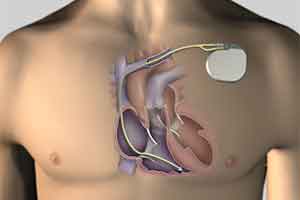Activity after ICD implantation may predict survival
 Patients who had higher activity levels following ICD implantation had better survival, according to research in the Journal of the American Heart Association. The research will be simultaneously presented at the Heart Rhythm Society 2015 Scientific Sessions.
Patients who had higher activity levels following ICD implantation had better survival, according to research in the Journal of the American Heart Association. The research will be simultaneously presented at the Heart Rhythm Society 2015 Scientific Sessions.
An implantable cardioverter-defibrillator (ICD) is a battery-powered device that typically combines a “generator” placed under the skin near the shoulder with a wire that is inserted into the heart through the vein beneath the collarbone. ICDs are very effective at recognizing fast, potentially life-threatening heart rhythm disorders and providing timely shocks that restore a normal rhythm. However, many patients who receive ICDs may still be at risk of dying from progression of their underlying heart disease or other problems.
In the largest study on the relationship between activity and survival in ICD patients, researchers analyzed how active participants were in the first 30-60 days after implantation and then over time up to four years. ICDs collect patients’ daily activity automatically using sensors embedded in the device itself, which determines whether patients are active or not on a minute-by-minute basis. “Active” measured in this way means approximately a walking speed of 2 miles anhour.
Researchers found:
Patients in the most active group after getting an ICD had a 40 percent absolute lower risk of death at four years compared to patients who had engaged in the least activity.
Regardless of age, gender or device type, lower average activity during the first 30-60 days was independently associated with a 44 percent higher risk of death over time.
A similar analysis looking at activity over several years demonstrated a similar risk of death for each 30 minutes’ difference in activity.
“We expected to see a difference, but we were struck by the magnitude of these results,” said Daniel B. Kramer, M.D., M.P.H., lead author of the study and assistant professor of medicine at Harvard Medical School in Boston, Massachusetts.
“Patients’ functional status clearly predicts survival. Our hope would be to use activity as a factor in not just predicting outcomes but also to guide strategies that may improve outcomes. But that is much further down the line.”
Researchers studied the ALTITUDE registry, a nationwide database that involved 98,437 patients enrolled in a remote monitoring program. About 57 percent of the patients had received a new or replacement ICD and 43 percent had received cardiac resynchronization therapy cardiac resynchronization therapy (CRT-D) devices in 2008-12. CRT-D therapy combines an ICD with cardiac resynchronization therapy. Patients were followed for a median 2.2 years.
“What is intriguing about our results is that looking at just one piece of information collected automatically after a device is implanted provides very powerful prognostic information about how they are likely to do over the next several years,” Kramer said.
The major limitation of the analysis, researchers noted, is that this study design only supports describing an association between activity and survival. Further studies are needed to test strategies aimed at promoting activity or using this information to change patients’ treatment.
Source: American Heart Association
Full bibliographic information:
Patient Activity and Survival Following Implantable Cardioverter-
Defibrillator Implantation: The ALTITUDE Activity Study ( J Am Heart Assoc. 2015;4:e001775 doi: 10.1161/JAHA.115.001775)

